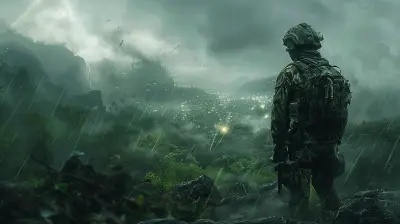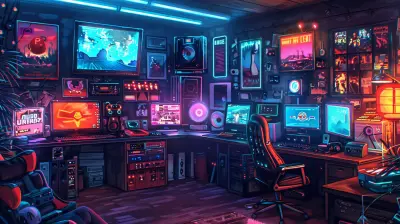Evolution of Single Player Games: From Pixels to Epic Worlds
22 May 2025
Video games have come a long way, haven’t they? From bouncing a tiny pixel across the screen in Pong to getting lost in sprawling open-world epics like Elden Ring, single-player games have evolved in ways few could have imagined. It’s like we went from sketching stick figures to painting full-blown masterpieces. So, let’s rewind the clock, trace the steps, and see how single-player games transformed into the immersive experiences we know today. Ready? Let’s dive in.![]()
The Dawn of Gaming: When Pixels Ruled the World
Back in the late 70s and early 80s, single-player games were simple—like really simple. We’re talking about a handful of pixels, some bleeps and bloops for sound, and gameplay mechanics that boiled down to a few straightforward tasks. Think Pong, Pac-Man, or Space Invaders. These games were groundbreaking at the time, but by today’s standards? They’re like flipping through black-and-white photos in a world of 4K movies.But hey, simplicity wasn’t a bad thing. These games laid the foundation. They had heart, a solid challenge, and an addictive charm. You didn’t need a 200-hour campaign to be hooked. Back then, surviving wave after wave of alien invaders? It felt like an achievement worthy of a standing ovation.![]()
The Console Boom: Welcome to the 8-Bit Era
Ah, the 80s. Big hair, neon everything, and the rise of 8-bit gaming. The release of the Nintendo Entertainment System (NES) brought single-player games into millions of living rooms. This era gave us classics like Super Mario Bros., The Legend of Zelda, and Metroid. Suddenly, games weren’t just about high scores—they were telling stories, and players were part of the narrative.In a way, this was where things started to get personal. Games like Zelda didn’t just ask you to play; they asked you to care. You weren’t just a nameless avatar—you were a hero with a mission. And let’s not forget the save feature. Oh boy, the ability to pause and pick up where you left off? Absolute game-changer.![]()
16-Bit Glory and Growing Depth
Fast forward to the early 90s, and the SNES and Sega Genesis were in full swing. Think of this as the puberty of gaming—everything was growing. The graphics? Sharper. The stories? Deeper. The worlds? Bigger. Games like Final Fantasy VI, Chrono Trigger, and Super Metroid raised the bar for what single-player adventures could achieve.At this point, games didn’t feel like games anymore—they felt like journeys. You’d spend hours exploring dungeons, solving puzzles, and uncovering plot twists that could rival a good TV drama. Developers weren’t just giving you a game; they were handing you a passport to another world.![]()
The 3D Revolution: Hello, Immersion
And then came the late 90s, when gaming went from 2D to 3D, and the industry collectively said, “Hold my joystick.” The original PlayStation, Nintendo 64, and later the Sega Dreamcast brought about a 3D gaming revolution. For the first time, we weren’t just looking at flat worlds; we were stepping into them.Games like Super Mario 64, The Legend of Zelda: Ocarina of Time, and Metal Gear Solid completely redefined what single-player games could be. They weren’t just games anymore—they were experiences. Remember that first time you galloped across Hyrule Field in Ocarina of Time? It wasn’t just a moment; it was a memory.
This era also marked the rise of cinematic storytelling. Developers began infusing their games with voice acting, cutscenes, and emotional depth. Suddenly, games weren’t just something you played—they were something you felt.
The Early 2000s: Bigger, Bolder, Better
By the early 2000s, gaming was hitting its stride. Technological advances allowed developers to craft more detailed worlds and complex narratives. Consoles like the PlayStation 2, Xbox, and GameCube brought us unforgettable single-player gems like Shadow of the Colossus, Halo: Combat Evolved, and The Elder Scrolls III: Morrowind.This era was all about ambition. Games started blending genres, tackling mature themes, and pushing the boundaries of what players thought was possible. Titles like Grand Theft Auto: San Andreas gave players freedom like never before, while Shadow of the Colossus proved that games could be art. Seriously, that game was like walking through a gallery filled with emotional gut punches.
The Modern Era: Open Worlds and Epic Narratives
Fast-forward to today, and single-player games are on a whole different level. We’ve got open-world games that feel alive, cinematic experiences that rival Hollywood, and storytelling that makes you question your life choices. From The Witcher 3 to Red Dead Redemption 2 to God of War (2018), modern single-player games aren’t just about playing—they’re about living.Take open-world games, for example. You’re not just following a linear story; you’re crafting your own adventure. Want to take on the main quest? Go for it. Want to spend hours fishing or hunting legendary animals? Knock yourself out. The freedom is unparalleled, and developers have gotten so good at creating believable worlds that, sometimes, it feels like you’re on vacation in a pixelated paradise.
And let’s not forget indie games. Titles like Hollow Knight and Celeste prove that you don’t need a massive budget to create something memorable. They offer unique, heartfelt experiences that stick with you long after the credits roll.
The Future: What’s Next?
So, where do we go from here? Virtual reality (VR) and augmented reality (AR) are already shaking things up, offering levels of immersion that were once the stuff of sci-fi dreams. Imagine stepping into a game world, fully immersed, with no controller in sight—just you, the game, and infinite possibilities.AI is another game-changer. Procedural storytelling and advanced NPCs could make game worlds feel even more alive. Imagine playing a game where characters genuinely react to your every decision, creating a unique experience every time you play.
But honestly? The future is anyone’s guess. If the past few decades are anything to go by, one thing’s for sure: single-player games will keep surprising us, one epic world at a time.
Why Single Player Games Still Matter
It’s easy to assume that, in a world dominated by multiplayer games and battle royales, single-player experiences might be losing their edge. But here’s the thing—single-player games offer something multiplayer doesn’t: solitude. They’re about you, your choices, and your journey. No lag, no teammates yelling in your ear, just you and the game.Whether you’re saving a kingdom, uncovering ancient secrets, or just vibing to a game’s soothing soundtrack, single-player games remind us why we fell in love with gaming in the first place. They’re personal. They’re timeless. And they’re here to stay.
all images in this post were generated using AI tools
Category:
Single Player GamesAuthor:

Luke Baker
Discussion
rate this article
3 comments
Cody McGeehan
This article brilliantly captures the journey of single-player games, illustrating how they've transformed from simple pixelated experiences to vast, immersive worlds. It's a testament to the creativity and innovation in game design, reflecting a true evolution in storytelling and gameplay.
June 11, 2025 at 4:59 AM

Luke Baker
Thank you! I'm glad you enjoyed the article and appreciated the evolution of single-player games. Your feedback means a lot!
Aiden Rios
Who knew our pixelated heroes would go from saving princesses in 8-bit to saving entire galaxies in stunning 3D? At this rate, I’m expecting my next adventure to involve time travel and toaster repair!
May 24, 2025 at 3:32 AM

Luke Baker
Absolutely! It's amazing to see how far we've come—who knows what the future holds for our gaming adventures!
Sabina Frye
This article beautifully captures the journey of single-player games, highlighting how advancements in graphics and storytelling have transformed our experiences. It's fascinating to see how nostalgia intertwines with modern epic worlds!
May 23, 2025 at 4:11 AM

Luke Baker
Thank you for your thoughtful comment! I'm glad you enjoyed how the article explores the blend of nostalgia and modern advancements in single-player games.


